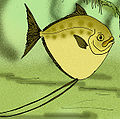Mene rhombea
| Mene rhombea Temporal range:
| |
|---|---|

| |
| Mene rhombea, from Mount Bolca, Verona | |
| Scientific classification | |
| Domain: | Eukaryota |
| Kingdom: | Animalia |
| Phylum: | Chordata |
| Class: | Actinopterygii |
| Order: | Carangiformes |
| Family: | Menidae |
| Genus: | Mene |
| Species: | †M. rhombea
|
| Binomial name | |
| †Mene rhombea (Volta, 1796)
| |
| Synonyms | |
| |
Mene rhombea is an extinct perciform fish belonging to the family Menidae. During the Middle Eocene (Lutetian epoch), about 48 to 40 mya, these fishes lived in the Tethys Ocean, a large tropical sea in the area corresponding to the current Mediterranean. This ocean was extended between the continents of Gondwana and Laurasia. At this time, where Monte Bolca is today, M. rhombea, and its relative, M. oblonga, lived in a tropical lagoon.
Description
[edit]Mene rhombea had a laterally compressed body, very long and slim pelvic fins and a wide triangular tail fin. As suggested by their fossils' small, upturned mouths, and by comparison of its living relative, as Mene maculata, fishes of this species were planktivore. The species shows close affinities with contemporary species inhabiting the coral reef environment of the Indo-Pacific warm seas.
Distribution
[edit]Their greatly valued fossils comes from the laggerstat Monte Bolca, about 30 kilometres north-east of Verona, Italy.
Gallery
[edit]-
Restoration of Mene rhombea
-
Mene rhombea, from Bolca
-
Mene rhombea specimen of the Lessini mountains in imprint and counterimpress
External links
[edit]




